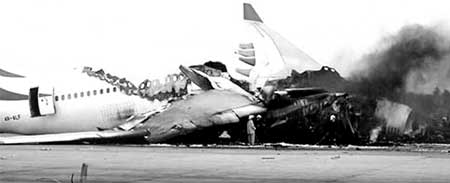
Security challenges in the airline industry
My memory runs back to little more than a decade ago when the British national news paper “The Observer” stated prominently in a centre spread, something like this - “British Airways Security is very good. Yet, it is not in the same class as Israel’s EL AL and Sri Lanka’s AIR LANKA”. It was indeed a world class tribute to a highly dedicated aviation security outfit that safeguarded the national carrier of Sri Lanka at the time - against all odds. Things have changed drastically since then. Firstly, there is no Air Lanka. Secondly, a clear majority of the key players of that outfit are NOW scattered - serving elsewhere. Thirdly and most importantly, two men (at the wrong end) have modulated the complexion of aviation security – both in the global arena and on the local platform. They are Osama Bin Laden and Vellupillai Prabhakaran. Out of the two, the latter is more experienced and of course, much senior in targeting the airline industry to meet the cruel ends of his terror thunderbolts. He goes as far back as the Avro aircraft explosion in 1978 at Ratmalana – almost a generation ago. Osama sprinted into action much later - exactly after 23 years - though in different style. It was he who forced aviation security designers to re-define the counter response applications world over. Until such time, the traditional academic belief was that - to blow up a flying aircraft and cause extensive damage, terrorists NEED to deploy at least a small quantity of explosives on board the plane. When brawn terrorism was replaced by brain terrorism, the terror plotters picked on the potential for the lethal explosion of AIRCRAFT FUEL upon impact. Many of us witnessed its destructive capacity in the 9/11 disaster – “LIVE” - courtesy a few video tapes. The WTC Twin Towers in the city of New York stood a “Collapsed” witness to this terrific innovation of Osama and company. Civil aviation is an illustrious business - primarily of passenger traffic and of air cargo movement – both domestic and trans-continental. These channels are directly in link with multi dimensional business facets or resources - and hence with the national economy of a country. Therefore, an attack against a passenger aircraft while in flight or on ground is both a psychological and political conquest to a terrorist group. Many terrorist organizations, including terrorists in Sri Lanka have done it repeatedly. Osama optimized the effect of destruction by leaping another step forward in using the targeted aircraft as a LETHAL FLYING BOMB to cause a colossal disaster in a selected strategic locality. Threat Perception The clear understanding that the airport is an INTERNATIONAL BUSINESS CENTRE which needs sensible professional security – not as a fortress that “also” accommodates aircraft movements - is a key to achieve subtly secured, yet smooth traffic passage for passengers and air cargo. The mitigation of threats to aircraft on ground and in flight – irrespective of the airport or the air space – needs a cohesive coming together among the airport security mechanisms and the security outfit of the airline concerned. It could be an armed assault, explosion on ground, aerial bomb, mid-air explosion or a missile attack targeting one or more aircraft. The airport of origin, the in-flight path and the airport of landing – all three need purpose knitted protective shield against each type of (current and future) terror penetrations.The aircraft hijack threat, for pressure purposes or terror purposes is still a harsh reality. Unfortunately, we prefer to rest our calculations on the declining (hijack) statistics and - the terrorists are NOT. That’s the difference - and also the regretting reason behind many “out of the blue” security failures. The Avenues Or think of an unaccompanied passenger baggage in transit - or a cargo package – or a catering trolley - or an air mail bag – or a replacement aircraft part in the fly away kit – or a saleable duty free pack on board – connected with a smartly hidden timer bomb. Often we rush to say it is NOT possible - until it happens. Then we quickly twist around to explain how it happened. The recorded history in here is such. Moreover, think of a navigation jamming device or electronic sabotage activity on board. Or radio- active and other hazardous cargo (intentionally) loaded without right precautionary packaging. The avenues are enormous and endless. All these could lead to frightening security and economic disasters. Consequences * Lives of the Passengers Concept Solution An airline training phrase sums it up most vividly - “If the best decorated heart surgeon in the world makes a mistake on duty, a single patient will die on a theater table. If an unsung airline security officer makes a mistake on duty, at least three hundred passengers will die at 33,000 feet up in the sky!!!” The author is Strategic Security Specialist / Pragmatic Trainer & CEO of Strategic Security Solutions. He can be reached at – |
|
||
| || Front
Page | News
| Editorial
| Columns
| Sports
| Plus
| Financial
Times | International
| Mirror
| TV
Times | Funday Times|| |
| |
Copyright
2007 Wijeya
Newspapers Ltd.Colombo. Sri Lanka. |
